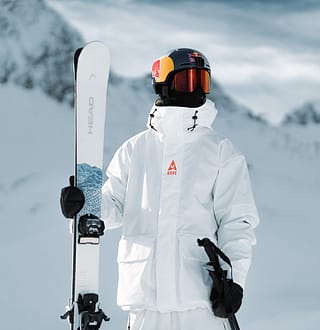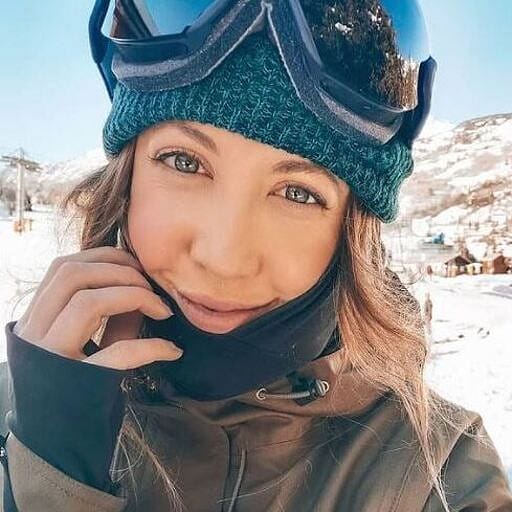What is freestyle skiing?
If you’re on the slopes, you’ll no doubt hear the word ‘freestyle’ thrown around. Not sure what is freestyle skiing? We’ve got you! Check out our answer to the question below – along with its incredible history and further info!

Freestyle. Is that anything to do with slopes, you might wonder? Off-piste? Park? (you’re getting warmer!). Or is it just for the Olympics? Don’t worry yourself with tons of questions – just lean on Dope Mag instead.
Yep, as always, we answer your burning ski and snowboarding-related questions. So buckle up – things are about to get inverted. Inspired to try a switch 180 in the park? Or hit that bump run like it’s nothing? Emulate the pros’ skills AND style with our fresh range of ski clothing. Why not treat yourself to a ski jacket and ski bib and showcase a fire new outfit?
Freeskiing explained…
Freestyle skiing is being creative on skis. It typically involves a series of acrobatic and aerial moves (usually combined) using man-made terrain parks, rails, kickers, and halfpipes. You can also call it freeskiing/freeski, jibbing, and more. But where did it come from? And who switched things up on the scene? Good thing we’re here – check out this discipline’s history, current standing, and future trajectory below.
A brief history of freeskiing

Let’s rewind to the early 70s when Rod Stewart was topping the charts, and Richard Nixon was president. All was quiet on those snowy mountains until ‘hot-dogging’ burst onto the scene! Believe it or not, ‘hot dog skiing’ was freestyle’s original name. It was coined after skiers combined riding with showmanship, subverting the traditional image of slaloming down the mountain. This was particularly true in 1971 when the first hot dog comp happened. Skiers threw themselves (sometimes literally) down a mogul run, with the highest scores awarded to those who sparked the best crowd reaction.
Okay, ski acrobatics has arguably been around since 1906. But it wasn’t until 1969 that New Hampshire’s Waterville Valley Ski Area formed the world’s first freestyle instruction program. And from there, things snowballed (pun fully intended). Championships and competitions took place across the US. And there were zero rules.
Then, in 1979, the International Ski Federation (FIS) recognized freestyle as an official sport. But that meant the FIS brought in new regulations around techniques to reduce the danger levels and boost safety throughout competition scenarios. It didn’t slow things down, though. Instead, freestyle went airborne, with Tignes hosting the first-ever FIS Freestyle World Ski Championships in 1986. Then, it became an Olympic sport:
- Albertville 1992 Winter Olympics: Mogul skiing becomes a medal event
- Lillehammer 1994 Winter Olympics: Aerial skiing becomes a medal event
- Calgary 1998 Winter Olympics: Freestyle makes its Olympic debut as a demonstration sport
- Vancouver 2010 Winter Olympics: Ski cross becomes a medal event
- Sochi 2014 Winter Olympics: Halfpipe and slopestyle become medal events
Disciplines and forms

As you might have noticed, there was a 16 to 20-year gap before the Olympic committee added more freestyle disciplines (ski cross, halfpipe, and slopestyle). Some say mogul skier Mike Douglas had a hand in this evolution of freeskiing in the 90s, which favored creativity and style over traditional technique.
The ‘Godfather of Freeskiing’ (as Douglas is known) stomped the snowboarders-only halfpipes and terrain parks alongside other skiers. Together, they proved that skiing could be just as creative as snowboarding and generate equal air time. Douglas also helped invent and pioneer twin tip skis (we’ll get onto those in a sec). For now, though, let’s drop into the other disciplines established throughout freestyle history, shall we?
Aerial skiing
This is all about launching off a steep slope, twisting and flipping mid-air (typically multiple times), and then stomping your landing. In competition, athletes are judged on form, takeoff, landing, and degree of difficulty.
Mogul skiing
Hate bumps? Then you don’t want to get into mogul skiing! Yep, this discipline involves skiers riding a mogul/bump run from top to bottom with skill and speed (and indestructible ACLs, it seems!). Most competition courses include two jumps for riders to perform aerial tricks. They’ll be judged on turn quality, speed, and their tricks off the jumps.
Ski cross
Ski cross is a race on a set course. You probably think that’s not wildly dissimilar from what you and your crew do on quiet slopes. However, ski cross involves several racers gaining speed and hitting multiple terrain features at the same time, such as banks and kickers. Slightly different to your crews’ corduroy laps, right? It’s the ski version of boardercross competitions (initially designed for snowboarders) and is judged on the fastest time rather than creativity.
Halfpipe
In the halfpipe discipline, skiers lay down multiple tricks off halfpipe walls rather than kickers. And these halfpipes aren’t mini – they’re normally around 22 feet/7 meters tall! Halfpipe competitions are about speed and creativity as riders launch themselves off the walls and lip to gain air and perform aerial maneuvers. Judges look for high-quality tricks and how well pros can stomp the landings.
Slopestyle
Slopestyle skiing focuses on conquering a course laden with kickers, rails, and features. Sound familiar? That’s because other sports such as BMX and skating inspired Slopestyle. In competition, skiers hit every obstacle on the descent with flair and creativity. And judges award factors such as difficulty, flow, execution, and style.
Big Air
The clue’s in the name – Big Air involves launching off massive jumps/kickers to perform tricks mid-air, crossing skis, and showcasing different grabs, too. Some Big Air comps center on kickers as large as 60 feet/18 meters *gulp*. Judges award points for the number of rotations and skills. Okay, you might think this is similar to aerial skiing, but there are differences. Firstly, the Big Air jump is way bigger. Secondly, creativity is heavily awarded in Big Air, such as landing switch (backward), which you wouldn’t normally do in aerial. Oh, and Big Air competitors tend to use poles, while aerialists go pole-free.
Equipment

Lightweight kit is the name of the game, as you don’t want extra weight when gaining speed or catching air! However, so is durability. That’s because freestyle skiers’ gear has to be able to withstand some inevitable slams (so wearing a helmet is key!).
Which skis are the best? Typically, freestylers ride twin tips, where the nose and tail slope upwards. This gives you the flexibility and stability to ride, land, and rotate in both directions. You’ll find this particularly handy when landing your trick, as sometimes you’ll land facing backward (also known as ‘switch’).
Poles are usually shorter and lighter than your typical slope poles. That’s so you don’t worry about tripping on them or becoming tangled as you slide along rails and catch air in the halfpipe. As mentioned, you’ll also notice some freestyle skiers ride without poles, especially aerialists.
The future
Freestyle events are a huge part of the Winter Olympics, X-Games, and skiing landscape – and there’s no doubt they will be for a long time. Freestyle is even found deep in the backcountry. In fact, some argue that the act of spinning off cliffs and even freeriding itself is the influence of freestyle.
In competition, superpipes are getting larger, and slopestyle courses are becoming bigger. Then, there are the tricks themselves – how many corks will become the standard? And will difficult tricks have to become even more technical as more riders add them to their bag? One thing that will never change, though, is that feeling of stoke and exhilaration. After all, stomping a triple cork is never going to feel dull, right? Plus, ‘hot dogging’ was born out of showmanship and wowing the crowd – and that’s here to stay, however freestyle progresses.
Of course, lil’ rippers and mini park rats will watch the pros in competitions and ski movies and want to emulate them and find their own style. Along the way, they’ll create a whole new gen of freestylers – and potentially new Olympic disciplines. For the everyday rider, though, freestyle is whatever you want it to be – whether that’s stomping tricks in the park or nailing your first 180. The clue is in the name – it’s the free-dom to be creative, express yourself, and spice up your next ride.
Wrapping up
Today, freestyle is Eileen Gu landing a double cork 1440 or Dope-sponsored Jesper Tjäder claiming the Olympic Bronze for Slopestyle. We know – who’d have thought something so niche would become such a global phenomenon, right? But it’s done it – and it’s only getting bigger and better.
Want to geek out on courses, tricks, and inspo? Join our Dope Snow Community Facebook Group and join like-minded skiers and snowboarders in chats about anything and everything snow-related. Keep your eyes peeled for exclusive collection previews, too. We might launch a few more styles made in collaboration with a certain freestyle pro…
Related reading:
